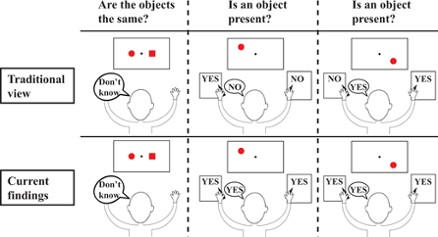I’ve talked before about Roger Perry’s famous split-brain patient experiments. Patients with severe epileptic seizures used to undergo a collosotomy, a procedure to cut the connections between the left and right hemispheres of their cerebrum. It often helped alleviate their symptoms and, remarkably, the patients afterward remained mentally functional, at least to outside appearances.
Each hemisphere of the brain controls and receives sensory input from half the body. What Perry and his colleagues discovered in their experiments, was that if sensory inputs going into the patient were isolated to one hemisphere or the other, each of the patient’s hemispheres were only aware of its own sensations, and with the language centers usually focused on the left hemisphere, the patient could usually only describe what they were seeing when the left hemisphere received it.
The fact that the patients, post-procedure, remained largely functional seemed to show that each hemisphere was effectively watching what the other half of the body did, and mentally confabulating the actions as its own. It opened up the possibility that this happens even in healthy people, albeit to a lesser extent.
However, new research appears to show that this phenomenon may be more limited than previously thought:
A new research study contradicts the established view that so-called split-brain patients have a split consciousness. Instead, the researchers behind the study, led by UvA psychologist Yair Pinto, have found strong evidence showing that despite being characterised by little to no communication between the right and left brain hemispheres, split brain does not cause two independent conscious perceivers in one brain. Their results are published in the latest edition of the journal Brain.
Source: Split brain does not lead to split consciousness
Assuming there are not any methodological issues with these new experiments (always a possibility), and given everything I’ve learned about the brain since first reading about the split brain patient experiments, I can’t say I find this too surprising.
The corpus collosum connects the cerebral hemispheres of the brain, but there are other regions which connect the two sides of the brain, mostly sub-cortical. These areas are generally below the level of consciousness, but the information from them feeds into the cerebrum.
These results are also consistent with the phenomenon of blindsight, where a patient that has sustained damage to visual processing centers in the occipital lobe (part of the cerebrum) cannot consciously see something, but if pressed, can often still identify it. The reason for this is that while the optic nerve does feed into the cerebrum, it also branches off to sub-cortical regions such as the superior colliculus in the mid-brain region. Again, the processing in those regions is below the level of consciousness (at least in humans), but it provides information, to a limited degree, to conscious regions.
It seems likely that, for the patients in the lower row of the image above, something similar is taking place. Each hemisphere may not be able to consciously perceive what the other hemisphere is seeing, but communication in sub-cortical regions is bubbling up into the cerebrum, enabling them to make the determinations that they’re making in the new experiments. Maybe.
But I’m not sure this necessarily justifies saying that the patient retains one unified consciousness. It may be that it is less divided than previously thought, but definitely is more separate than the consciousness of healthy people. Of course, I’m basing these remarks on the press release. The actual paper may shed additional light.
I definitely plan to watch for any new developments in this area. Or for any comments from Michael Gazzaniga, one of Perry’s assistants who are still around and writing.

I wonder if the split-brains have somehow adapted to the split? Those patients must be in their sixties or even older now and would have spent most of their lives with split brains. We know that the brain is capable of great plasticity in other cases.
LikeLiked by 1 person
They actually speculate on exactly that possibility in the paper. The two patients that were tested had their procedure several decades ago when they were young. (It’s rarely done anymore.) It might be that the pathways eventually rewired themselves, or existing pathways got stronger.
LikeLike
‘Press release’ — sorry Mike.
LikeLiked by 1 person
Fixed! Thanks Hariod.
LikeLiked by 1 person
Based on this alone, I don’t think we can rule out the idea of two consciousnesses in one brain. It seems to me that they could share sensory information and still be separate entities, just as two people can share some of the same experiences without becoming the same person.
LikeLiked by 1 person